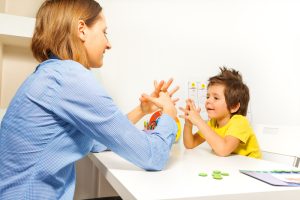Going back to school can be a daunting and difficult process for children with autism. It can be a particularly trying time for both parents and children as the transition from summer vacation to the school routine can be a challenge.
There are many ways to make the back-to-school process easier, however. My World ABA discusses various tips that can help ease the transition back to school for children on the autism spectrum.
Communicate With Teachers
One of the most important things you can do to ease the back-to-school transition for your child who is autistic is to communicate with their teachers. The more your child’s teachers know about their unique needs and challenges, the better equipped they will be to support them.
It’s important to remember that your child’s teacher is not a mind reader. They may not be aware of your child’s specific challenges or what works best for them in terms of communication and learning. By communicating with the teacher, you can provide them with important information about your child’s needs, interests, and strengths.
Sharing information about your child’s strengths can also help the teacher tailor their approach to teaching. For example, if your child is particularly good at math but struggles with reading comprehension, the teacher can focus on using math-based examples to help your child learn in other subjects.
It’s important to establish open lines of communication with your child’s teacher. This can help you stay informed about your child’s progress and any challenges they may be facing. Working together as a team can help ensure that your youngster’s needs are being met and they are progressing academically and socially.
Related Post: Maximizing Your Child’s Comfort: The Importance of a Sensory Backpack For Autism
Visit the School Before the First Day
Visiting the school before the first day can be incredibly beneficial for children with autism. It allows them to familiarize themselves with the school environment, meet their teachers, and understand what to expect. This can help alleviate anxiety and reduce the chances of overwhelming sensory experiences on the first day.
By visiting the school, your child can explore the layout of the building, locate their classroom, and become acquainted with the different areas such as the cafeteria, gym, or playground. This familiarity can provide a sense of security and help them feel more at ease when school starts.
Meeting their teachers in advance also allows your child to establish a connection and begin building a rapport. They can have the opportunity to ask questions, share their interests, and get to know each other better. This can contribute to a smoother transition, as your youngster will have already established a level of comfort with their teachers.
Additionally, visiting the school can provide an opportunity to discuss any specific accommodations or strategies that may be helpful for your child. By having these conversations beforehand, the school can better prepare to meet your child’s needs.
Provide Visual Schedules and Social Stories
For children with autism, having a visual schedule can help them understand what is expected of them throughout the school day. This can include a list of activities or tasks that they will be doing, as well as when and where they will be doing them. Visual schedules can be made using pictures, symbols, or words depending on what works best for your child.
Social stories are another effective tool to prepare your child for the school routine. A social story is a short story that explains a specific situation or task in detail, using clear language and pictures. This can help children with autism better understand what will be happening at school and what they can expect from the experience.
Visual schedules and social stories can be particularly useful during the transition to a new school year. Creating these tools together with your child can help them feel more in control of the situation and build confidence. It’s also a good idea to have a copy of the visual schedule and social stories available in the classroom for your child’s teacher to refer to throughout the day.
Make Sure You Have an IEP
An individualized education program (IEP) is a critical document that outlines the educational goals and services your child with autism needs. As a parent, it’s essential to ensure that your child’s IEP is up-to-date and adequately addresses their unique needs before the school year begins.
To make sure your child’s IEP is current, communicate with their healthcare providers, therapists, and teachers. It’s crucial to have open and honest conversations with them about your child’s progress and challenges to create an effective plan.
Also, double-check that the IEP includes any new therapies or medications your child may need and that the accommodations listed meet their specific requirements.
Finally, make sure that your child’s teachers have a copy of the updated IEP. Teachers must understand and implement the IEP goals to support your child’s academic and social success. By staying on top of your child’s IEP, you can ensure they receive the necessary support and achieve their academic and developmental goals.
Related Post: What is an IEP and How Does Your Child Benefit From Having One?
Autism Therapy in Springfield and Joplin
My World ABA provides ABA therapy in Joplin and Springfield, MO. Our approach is based on kindness and understanding, and we strive to create a fun and inclusive environment where your child will feel welcome.
To learn more about our services or answer additional questions, visit our website or call (417) 818-5784 today.





